How do you choose your mala for your mantra recitation practice?
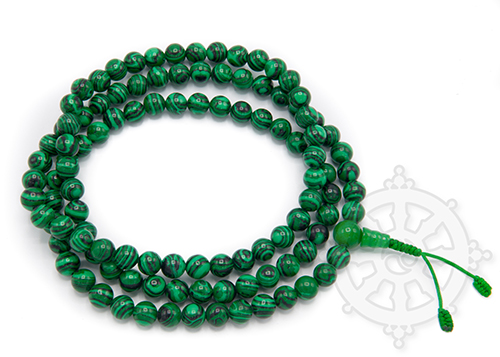
Rosary (Mala/Thrèngwa)
This description is taken from the excellent book by Lama Cheuky Sengué, which we advise you to buy, "Petite encyclopédie des Divinités et Symboles du bouddhisme tibétain", published by Claire Lumière.
The mala is the Buddhist rosary. Attribute of the deities, it is also the usual object that practitioners use to recite mantras. It is used as a tactile support, at the same time allowing to count the mantras if one has set oneself to repeat a definite number of them.
The mala is composed of 108 strung beads, which justifies its name, since it simply means "garland of beads". The different components each have a specific symbolic meaning:
- The large pearl, often made of ivory or bone, which closes the loop represents the knowledge of emptiness.
- The small cone: which surmounts it is the mark of emptiness itself.
- The cord : on which the pearls are threaded must, theoretically, be presented as a braid of several threads :
- Three threads symbolize the three bodies of a Buddha (absolute body, body of glory, body of emanation);
- Five threads symbolize the five wisdoms or the five families of Buddha;
- Nine sons symbolize the primordial Buddha Vajradhara and the eight great bodhisattvas.
- The counter ending with a small vajra represents skillful means and compassion. Its ten rings are used to count the hundreds of mantras.
- The counter ending with a small bell symbolizes knowledge and emptiness. Its ten rings are used to count the thousands of mantras.
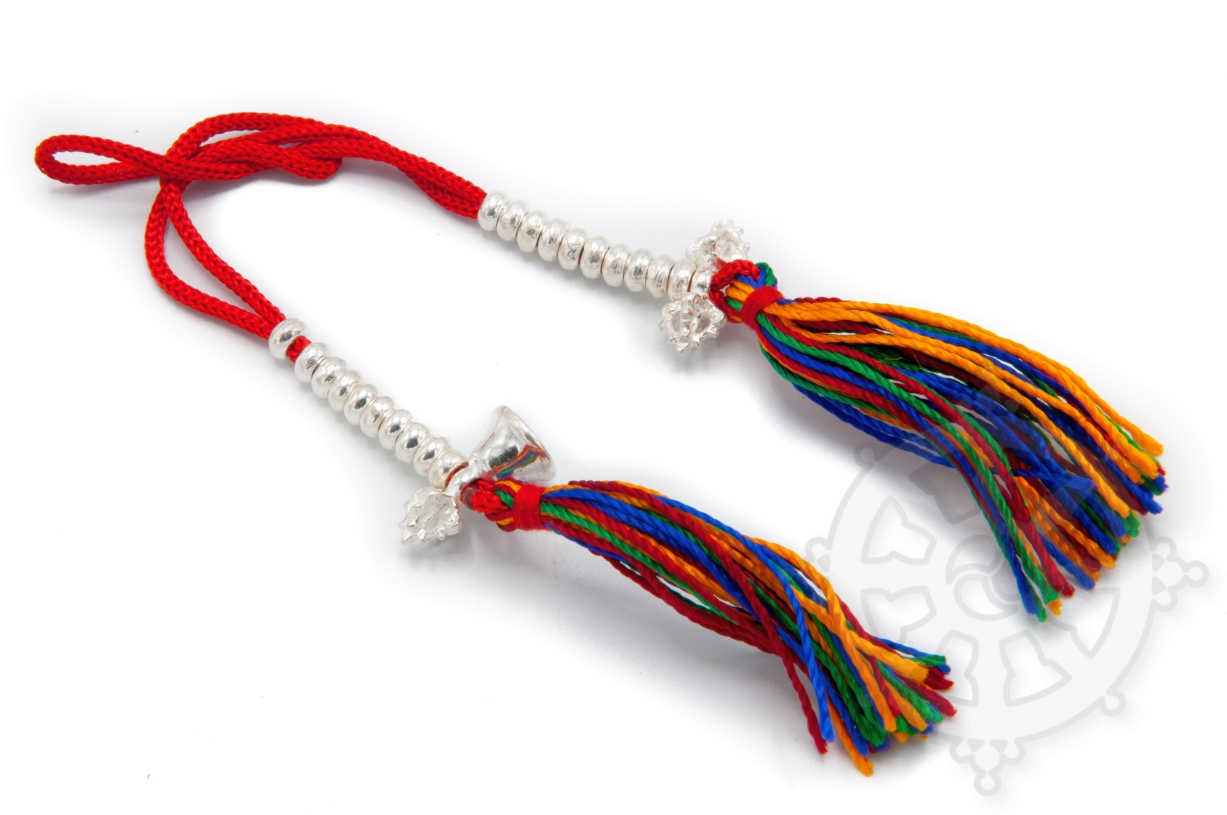
The recitation counter with the bell and the vajra
The beads themselves can be of different materials. For the deities, it most often reminds the color of their body:
- Ruby, if the deity is red;
- In crystal, if it is white, and so on.
There are 108 beads for long recitations of prayers and 21 for the malas worn on the wrist.
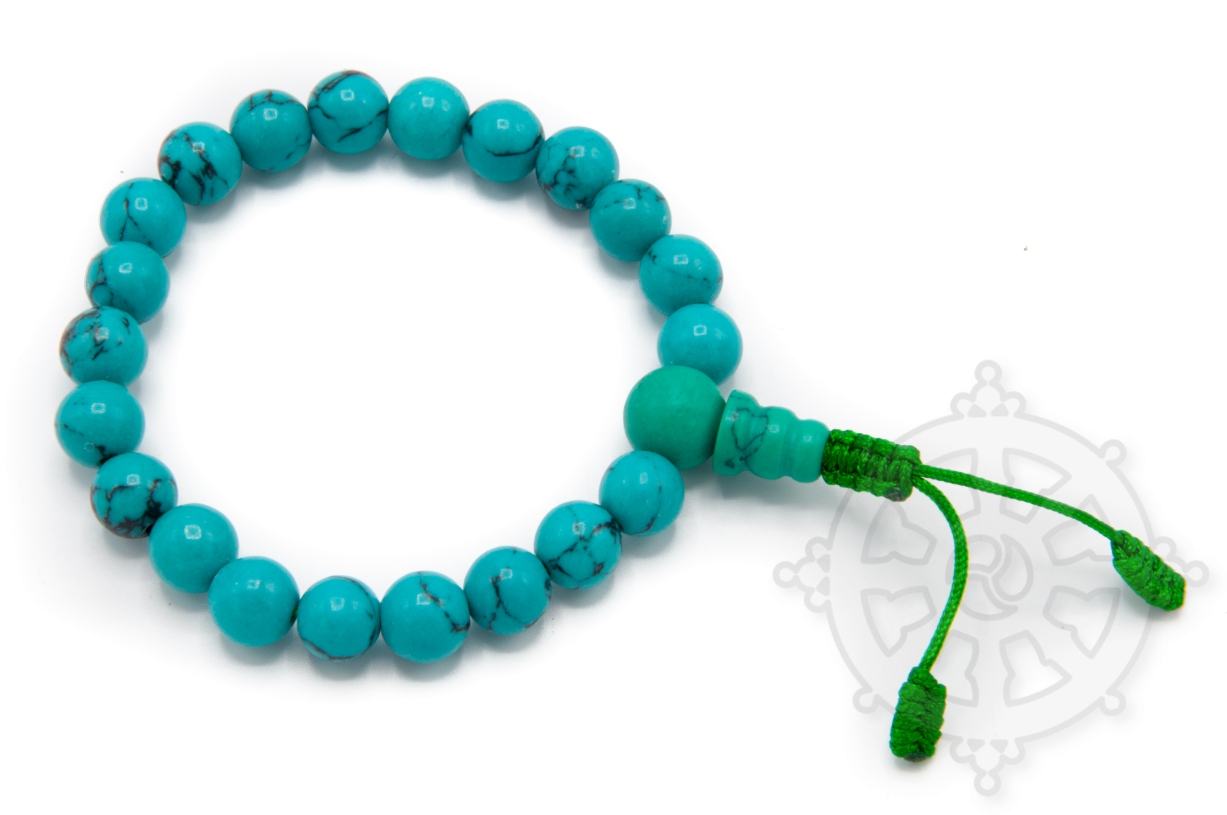
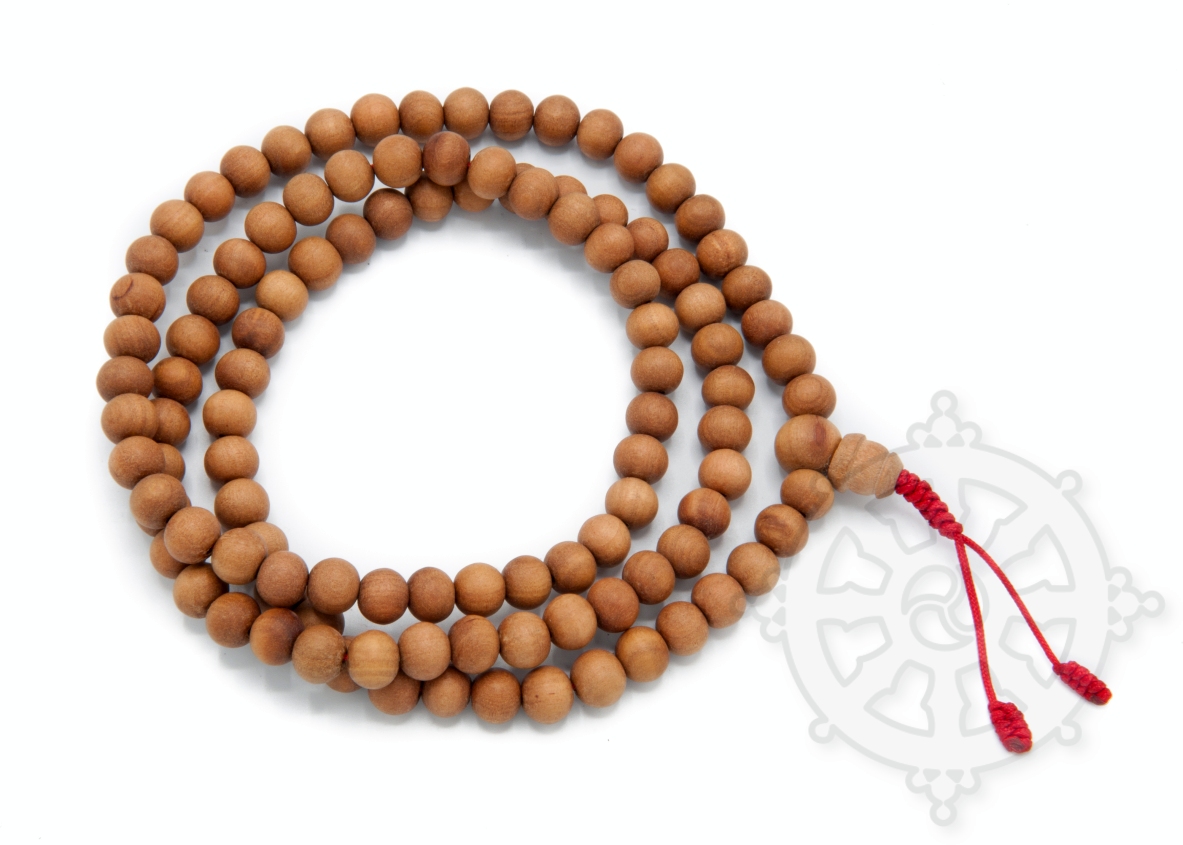
How to choose your mala?
For regular practitioners, the beads will be made of seeds from the Bodhi tree, sandalwood, semiprecious stones, coral, etc. Depending on the activity one wants to accomplish, associated with specific mantras, some beads may be preferred to others. So how do we choose the type of beads for our mala?
A mala according to the mantra recited
Every mantra is associated with a deity. And each of these deities has a series of attributes among which we find the main color of the deity (Buddha Amitabha: mala of RED stones, Green Tara: mala of green stones, Buddha Sangye Menla: mala of blue stones, etc.). One can therefore choose his mala according to his divinity of reference.
A mala according to the energy you wish to work on.
Depending on our physical or mental state, we may wish to work on certain energies such as :
- appeasement, i.e. to dissipate internal disturbances, diseases, conflicts, etc.: crystal, mother-of-pearl or light-coloured matter beads are preferred;
- Increasing life span, knowledge, merit: gold, silver, copper, lotus seeds, mulberry wood are recommended;
- dominance: red sandalwood, various odoriferous substances or coral are used;
- Subjugation: Rudrakaksha seeds, bone, iron, turquoise, acacia or black thorn are used.
In connection with work on the chakras
If the objective is to work on a specific chakra, click here to see the table of correspondences of the mala materials with the 7 chakras.
Buy a mala "by default"
In spite of all these specifications that can be complied with, the practitioner usually uses the same mala, usually in seeds from the Bodhi tree, in so-called lotus seeds or in wood. These are the most commonly used malas. It must also be possible to re-string the beads of one's mala before the cord breaks as a result of wear and tear.
How to use your mala?
Reciting mantras with your mala
The mala is held in the practitioner's left hand (but is sometimes found in the right hand of certain deities). It is shelled by pulling the beads towards oneself, which symbolizes that one is pulling beings out of suffering. Each round ends with the large pearl and, without crossing it, one turns the mala over to go back the other way. Although the mala counts 108 beads, each turn is counted as 100, with the remaining 8 recitations being "offered" for possible mistakes made during the recitation.
What to do with the mala when you don't use it?
If you do not carry it with you, make sure it is kept in a clean place like any object of religious practice. To this end, you can use a pouch specifically designed for your mala.
The mala is a very personal object. It is considered that prayers recited with its help "charges" the mala with a specific energy. It is not uncommon to see practitioners ask their master to bless their mala. The latter then begin to recite some mantras with the mala of the disciple and/or blow on it in order to charge it energetically.
How to maintain one's mala?
There is little to report about the maintenance of the mala itself.
It is possible that the rope will wear out. Before it breaks, the rope must be changed. Be sure to follow the instructions in a good online tutorial and use a specific rope for malas as they are designed specifically to resist wear and tear.
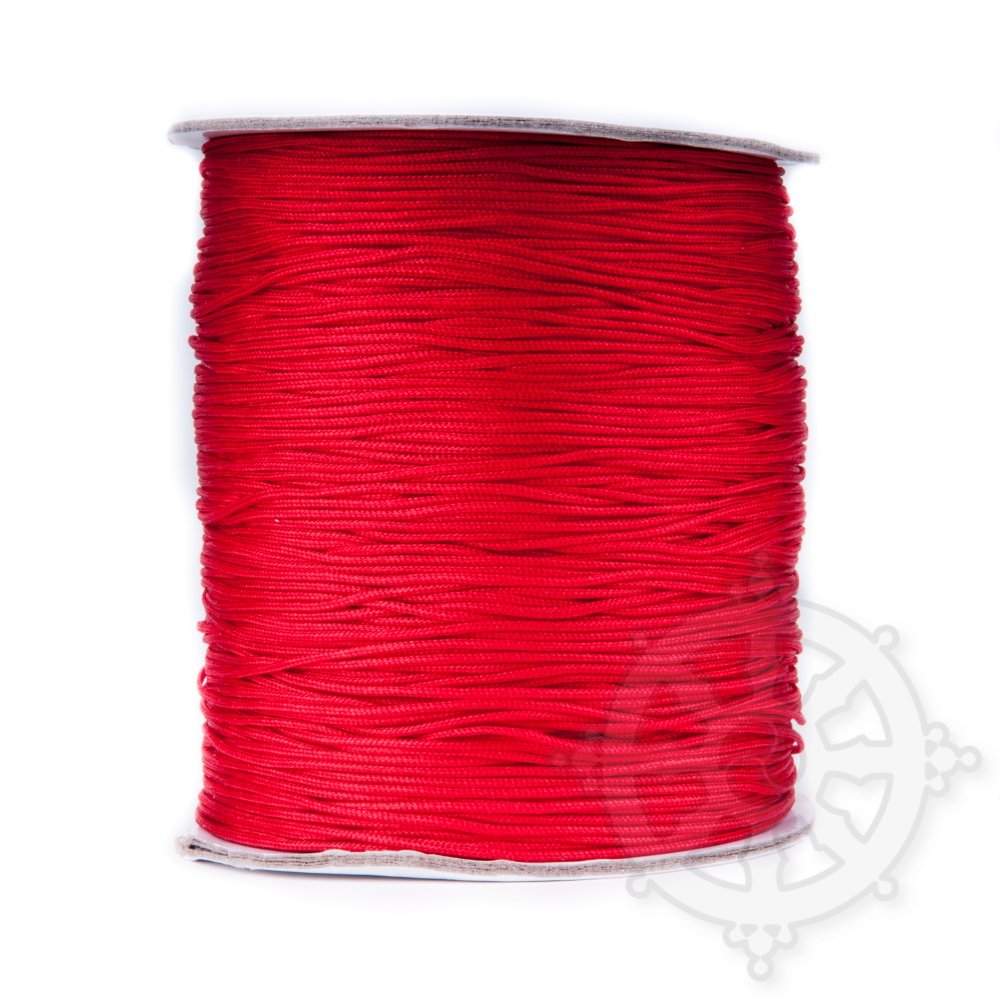
Disclaimer
The-dharma-store.com has set itself the goal of providing quality materials to European Buddhist practitioners and centres. To this end, when we purchase materials, we work exclusively with artisans who have a long reputation for excellence and ethics in the craft market.
If certain original materials are too expensive and we have the possibility to obtain alternative materials for a better price/quality ratio, we systematically point this out in our product descriptions. When our suppliers give us precise information on the origin of the materials and their manufacturing process, this information is also made available to our customers.
As far as malas, their materials and their manufacture are concerned, here are some warnings that we bring to your attention:
- Reconstituted stones: These are residues of natural stone that have been pulverized and then agglomerated with resin. A simple technique to recognize such stones is to prick them with a needle heated to red to see if it sinks into the stone, thus attesting to a resin treatment of the stone.
- Artificial stones: Various processes can be used to create artificial stones in the laboratory. They are sometimes very difficult to recognize even under a microscope. They can sometimes be recognised by a needle test.
- Precious wood (such as sandalwood): The original sandalwood or "Santalum album" is an endangered plant species, the exploitation of which is highly regulated by the governments of India, Pakistan and Nepal. This makes it a very expensive species from which the essential oil of sandalwood that is extracted from it reaches prices of $1,000 to $1,500 per kilogram. It is therefore practically impossible to find malas made from the variety "Santalum album". Nevertheless, there are certain varieties of sandalwood (or not) that have the same scent and/or the same type of oil such as Adenanthera pavonina, Baphia nitida, Eremophila mitchellii, etc. Most of the so-called "sandalwood malas" are made from these species.
- Bodhi Seeds: There are malas made of Bodhi seeds which are sometimes sold for several thousand euros. But what are all these "Bodhi Seed" malas at varying prices? The seeds of the Bodhi tree are beige in colour, they have many dark purple markings on the surface and fall naturally from the tree. Because the fruit has a rounded shape and the material is hard and dimensionally stable, it can be used to make rosaries after processing. But there are different types of trees producing these seeds and therefore these are identified :
- according to their different markings and colours on the surface to name them: like the Bodhi "moon star", the Bodhi "eye of phoenix", the Bodhi "eye of dragon", etc,
- according to their place of origin: the Bodhi of Tianzhu, the Bodhi of Tiantai, etc.
- The lower the production, the smaller the seeds are and the rarer they are and therefore the malas made with these seeds are very expensive.
- Amber: There are practically no malas made of amber whose price would be prohibitive. Very often these are malas made of artificial material which is much lighter than stone. You only have to weigh the mala to realize how light it is.
Some advice about your mala
The mala, like any instrument of religious practice, must be respected with circumspection. We remind you here of some ethical rules:
- Malas are personal objects of practice which have the power through the recitation of mantras to protect us and help us on the path to liberation. They should therefore be treated with respect, i.e. kept away from the ground and places where people sit or walk or from unclean places.
- Teachers teach us that the Malas "take charge" of the prayers and rituals we perform with them. They are therefore an intimate object of our practice that cannot be lent or exchanged except to be blessed by a Lama.
- The malas should be protected in a suitable bag for transport and not be mixed, for example, with dirty linen.
- Malas are not jewelry. Acquiring a mala implies that one wishes to use it for one's practice and therefore it is necessary to devote a privileged place to it where it will remain outside of the moments of practice.
- If you no longer wish to keep your mala, don't throw it away! Please contact the nearest Buddhist center and make a donation. By doing so, this object will give you the benefit of its merits until the end of your relationship.
These are some non-exhaustive rules of Buddhist ethics that you are free to respect or not.
The Seeds of Bodhi
Different types of seeds
The seeds of the Bodhi tree are called Bodhi seeds; beige in colour, they have many dark purple markings on the surface and fall naturally from the tree. Because the fruit has a rounded shape and its material is hard and dimensionally stable, it can be used to make rosaries after treatment. Such rosaries are usually called "Bodhi seed malas". As some special Bodhi seeds have Sanskrit-like markings on the surface, they are called "Vajra rosaries".
If we use the Bodhi Seed Malas seriously for a while, the Bodhi Seeds begin to feel smooth and oily, making people want to keep them.
The different types of Bodhi seeds can be divided into two types:
- according to their different markings and colours on the surface to name them: like the star moon Bodhi, the phoenix eye Bodhi, the dragon eye Bodhi (longan) etc,
- according to their place of origin: the Bodhi of Tianzhu, the Bodhi of Tiantai, etc.
Notes on the naming "Bodhi seeds".
- The seeds of the Bodhi moon star Bodhi are hardy brown in colour. On each seed there is a large round eye that symbolizes the moon and is surrounded by countless small eyes representing the stars, hence the name of the Bodhi seed "moon stars". According to history, during the Liang Dynasty in South China, the monk Zhiyao brought a Bodhi tree from Tianzhu to the east of Guangzhou; the seeds of this Bodhi tree had large circles on the surface, marks like the moon, small dots like the stars, they were called Bodhi star-moon seeds.
- The seeds of the Phoenix-eye Bodhi are also hardy brown in colour. On each seed there is a beautiful elegant eye symbolizing the fact that we must have a unique eye, an eye out of the ordinary, a beautiful eye, an eye of wisdom, an eye of compassion, an eye of forgiveness to contemplate the impermanent world, so that we may live with freedom and clarity.
- The seeds of the Bodhi eye of dragon correspond to a type of seed of the Bodhi because the buds look like triangles; according to the custom, they are called Bodhi "eye of dragon".
- The seeds of the Tiantai Bodhi in China are called Bodhi Tiantai; they are of very high quality, very hard, and remain unchanged over time. In addition, the more they are used, the more polished they are; the new beads are yellow in colour, and after long use, the light colour becomes dark, turning to red or dark brown.
